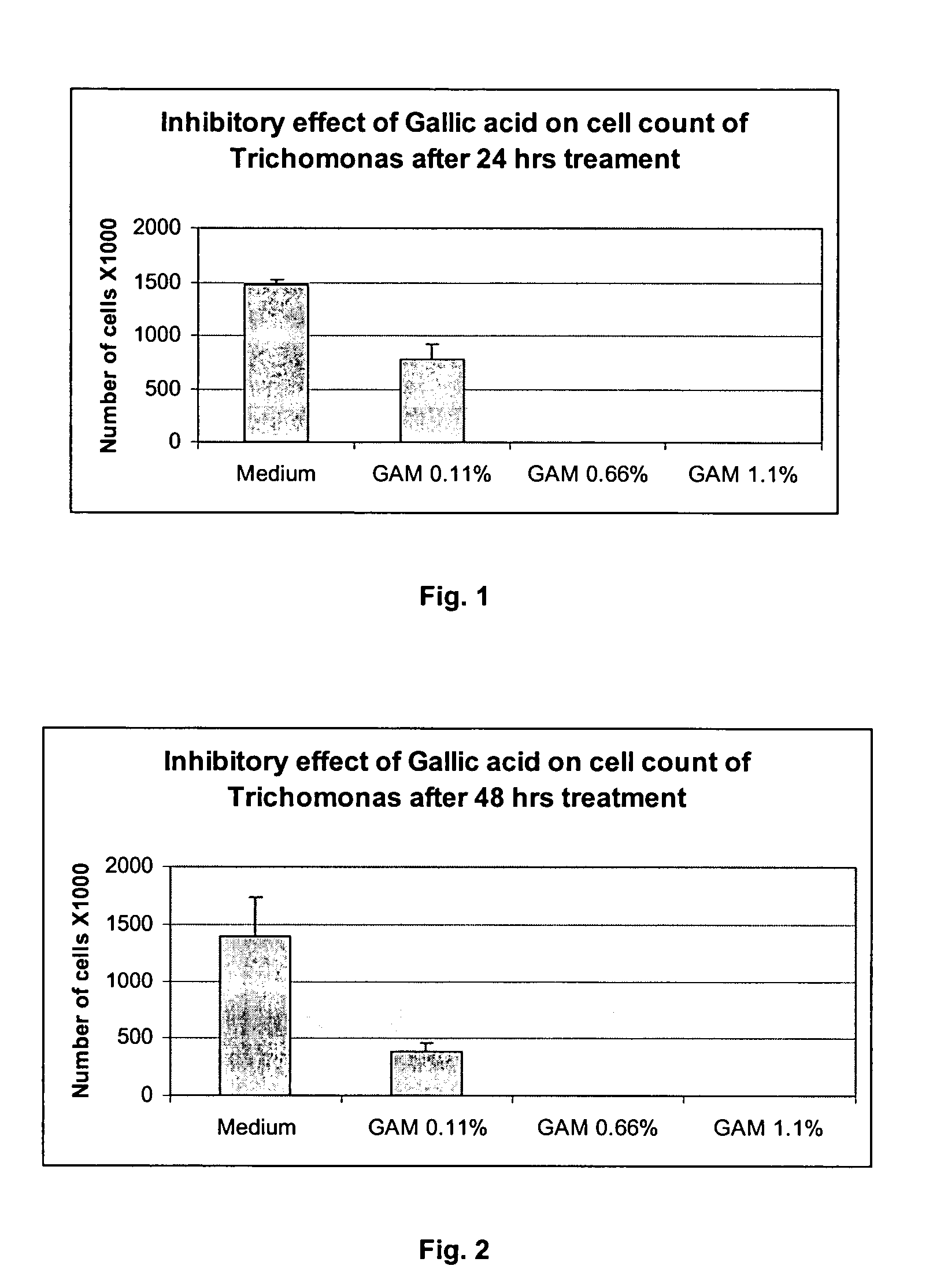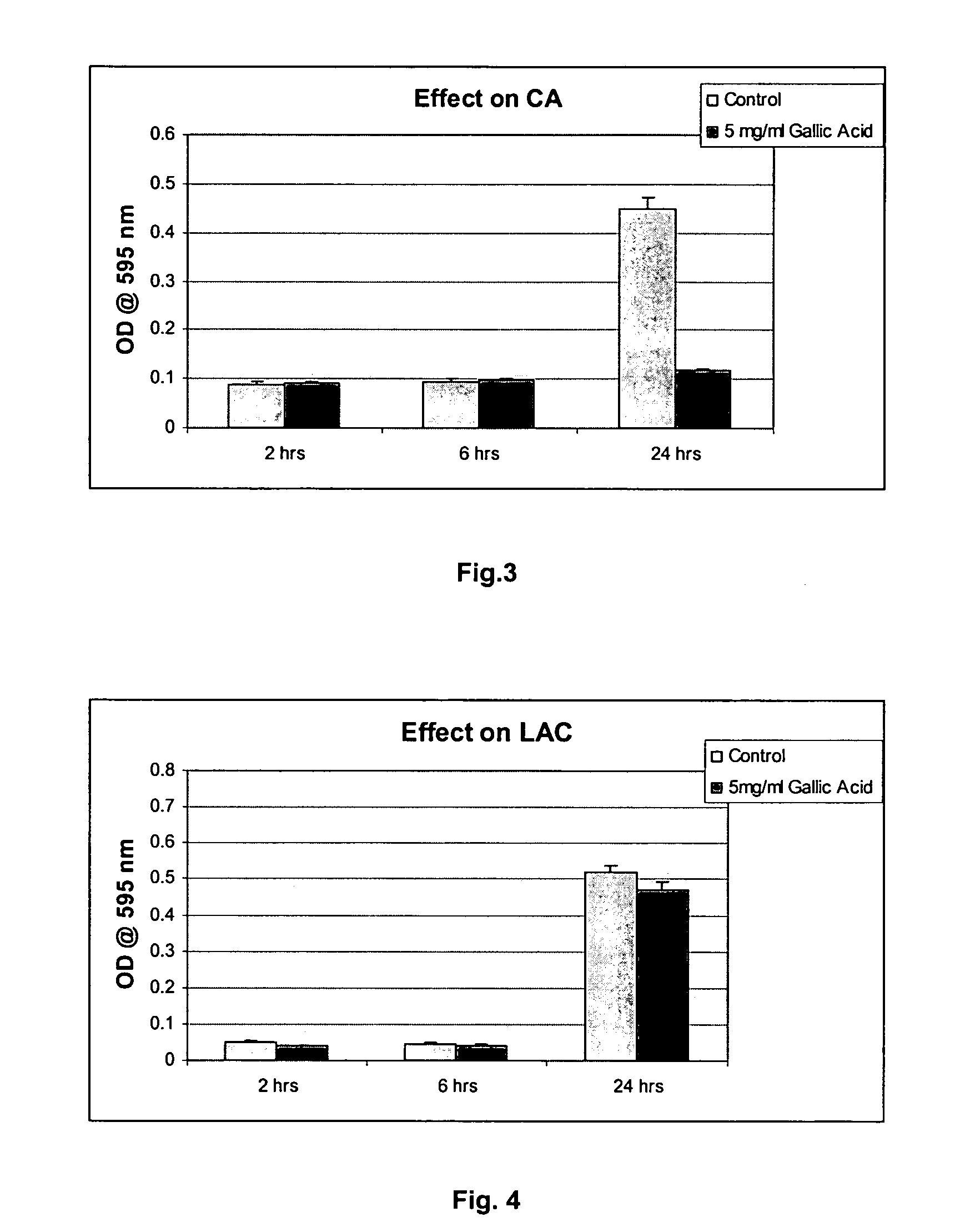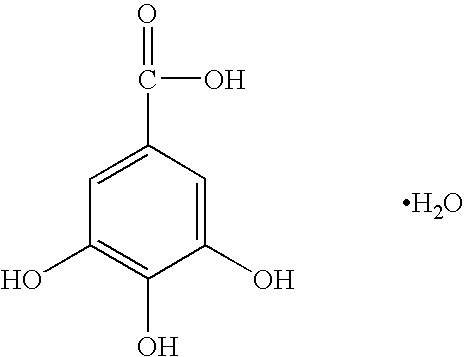Method for preventing and/or treating vaginal and vulval infections
a vaginal and vulva infection technology, applied in the direction of biocide, drug composition, sexual disorder, etc., can solve the problems of increasing the risk of recurrence increasing the risk of bacterial vaginosis or the development of a different vaginal infection, etc., to prevent and/or treat vaginal and vulva infections, inhibiting and/or killing, and preventing vulva infections
- Summary
- Abstract
- Description
- Claims
- Application Information
AI Technical Summary
Benefits of technology
Problems solved by technology
Method used
Image
Examples
example 1
Effect of 1.1 Percent Gallic Acid on the Growth of Trichomonas vaginalis
[0031] A sterile LYI-S-2 medium was prepared according to the manufacturer's instructions, and the pH of this medium was adjusted to pH 6.0 using 1 N HCl. Gallic acid monohydrate (SIGMA-398225 from Signa Aldrich, USA) was dissolved in the LYI-S-2 medium. The gallic acid monohydrate was found to be only partially water soluble, and the highest concentration of gallic acid that could be obtained in water was 1.1 percent (g / 100 milliliter). 0.9 milliliter of the gallic acid / LYI-S-2 solution or culture medium only (as control) was added into different culture tubes.
[0032] 0.1 milliliter of Trichomonas vaginalis culture suspension, at a concentration of 1×106 / milliliter, was added to each of the culture tubes, which were then incubated at 35 degrees Celsius on a 15 degree horizontal slant.
[0033] The viable Trichomonas vaginalis cells in each tube were counted under a microscope after 24 hours.
[0034] This procedur...
example 2
Effect of Various Concentrations of Gallic Acid on the Growth of Trichomonas vaginalis
[0036] Essentially the same procedure was performed as described in Example 1, but this time differing concentrations of gallic acid were tested on samples of Trichomonas vaginalis. The gallic acid concentrations that were tested were: 0.11 percent, 0.66 percent and 1.1 percent. More samples in each group were included (n=4), and the effects of the gallic acid over a longer time period were also observed, i.e. after 24 and 48 hours.
[0037] As shown in FIGS. 1 and 2, gallic acid at a concentration of 0.11 percent showed a 50 to 70 percent inhibitory effect on Trichomonas vaginalis cell counts after 24 and 48 hours, respectively, compared to the control group (medium only). No live Trichomonas vaginalis cells were observed in the samples that were treated with gallic acid concentrations of 0.66 or 1.1 percent, either after 24 or 48 hours.
example 3
Effect of Gallic Acid on the Growth of Candida albicans and Lactobacillus acidophilus—Zone-of-Inhibition Test
[0038] A microorganism culture of 105 cfu (colony forming units) / milliliter in a 1× phosphate buffered saline (PBS) solution (diluted from 10× PBS LIQUID CONCENTRATE from VWR Cat. No. EM-6507] was prepared for each of Candida albicans and Lactobacillus acidophilus. One milliliter of each solution was plated on proper agar plates, depending on which microorganism was being tested. The agar plates were incubated at 35 degrees Celsius for four hours. Three 4 millimeter diameter wells were then punched into each agar plate. A test sample of 10 mg / ml gallic acid in sterilized 2-N-morpholino ethane sulfonic (MES, pH=4.7) buffer (0.1 M 2-[morpholino]-ethanesulfonic acid, 0.9 percent NaCl, pH 4.7, prepared from BupH™ MES Buffer Saline Pack from Cat. No. 28390, Pierce Biotechnology, Inc., Rockford, Ill.) was added to one well of each plate. Into each of the other two wells were added...
PUM
| Property | Measurement | Unit |
|---|---|---|
| pH | aaaaa | aaaaa |
| time | aaaaa | aaaaa |
| time | aaaaa | aaaaa |
Abstract
Description
Claims
Application Information
 Login to View More
Login to View More - R&D
- Intellectual Property
- Life Sciences
- Materials
- Tech Scout
- Unparalleled Data Quality
- Higher Quality Content
- 60% Fewer Hallucinations
Browse by: Latest US Patents, China's latest patents, Technical Efficacy Thesaurus, Application Domain, Technology Topic, Popular Technical Reports.
© 2025 PatSnap. All rights reserved.Legal|Privacy policy|Modern Slavery Act Transparency Statement|Sitemap|About US| Contact US: help@patsnap.com



